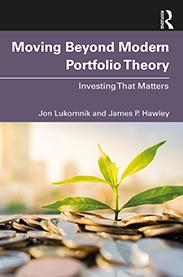(Note: Jon Lukomnik is a senior fellow of High Meadows Institute. This article is adapted from their new book, Moving Beyond Modern Portfolio Theory: Investing That Matters to be published in April.)
Viewed with historical distance and perspective, the connections between norms, law, regulation and corporate behavior are quite apparent. What is considered socially (market) acceptable changes over time and location, sometimes slowly and sometimes quite rapidly. Slavery, while always controversial among non-slaves (hardly controversial among enslaved people), was part and parcel of early capitalism, but eventually made illegal (though we note that quasi-slave and clandestine practices continue). The same with child labor, labor health and safety standards, hours of work, workplace discrimination and a host of other issues.
Corporate behaviors adjust eventually, albeit unevenly. Consensus is neither universal nor instantaneous. Those firms who cling to the old social norms past the effective date (creating regulatory risk) sometimes complain that they are being penalized for doing what they have always done, and that the rules have shifted under them. They are correct: Shifting societal values cause shifting laws reflecting shifting beliefs.
Companies and investors traditionally regard values, during the period when they are coalescing into societal norms, as “non-financial.” A better term might be “not-yet-financial,” making it clear that norm shifts and new understandings, once adopted by a critical mass of investors, firms, the general population, and sometimes regulators, become financially relevant and sometimes legally “material.” Companies and investors who are sensitive to this process of how issues become widespread and then viewed as value-creating or value-destroying, can benefit from positioning themselves where society is moving, rather than where it has been. The social construction of markets has been widely studied by sociologists, anthropologists, economists, organizational theorists and others.
Of course, norms are not just about ethics and morality, but encompass all evolutions in what society considers acceptable behavior. Our improved understanding of science also forces us to confront those insights. For example, it had been known for millennia that ground water can be contaminated, thereby impacting not just the ecosystem, but production and livelihoods that depend on potable and useful water. But, as those understandings deepened and changed, new norms of behavior developed. From these, new regulatory and legal standards developed, most typically over the intense opposition of the polluting firms. Today, issues such as climate change, how to deal with the pandemic and loss of biodiversity continue those science-driven changes.
The evolution of human knowledge and beliefs means the specifics of what is material are always in flux. Materiality from this perspective is not a state of being but a process of becoming over time. Jean Rogers and George Serafeim suggest that when firm practices and social norms diverge enough, there is a catalyst for the “becoming material” process. Stakeholders (including investors and regulators) react to these changes. In turn, companies often, but far from always, respond if they perceive either opportunity, or if their interests and reputations are threatened.
Two relatively recent major changes affect the context of the “becoming material” process. One is how the world invests today, and how that conflicts with the legal basis for materiality and all that implies, such as required corporate disclosures. Legally, materiality in the United States relates to what facts a reasonable investor would consider in making an investment decision regarding a particular security. Yet most investors hold diversified portfolios, such as in an S&P 500 index fund. For a diversified investor, systematic risks to the market overall, rather than to a particular company, drive the vast majority of risk and return. The question for that investor, then, is both how does a particular risk factor, such as climate change, affect a particular company, but also how does that company affect the systematic risk that climate change poses for the overall portfolio. In other words, it is not just outside-in materiality, or what the world does to a particular company that a diversified investor needs to understand, but inside-out materiality, or what that company does to the world.
This “double materiality” concept is increasingly recognized around the world, both for the diversified portfolio reason cited, and for another contextual change: The sheer scale of global companies today. Corporate impact on what information you absorb, how and what you eat, your health, and your wealth is far greater than it was even a generation ago. Corporate impact on our daily lives rivals if not exceeds that of government. Small actions that deviate from social norms, which a generation ago would not have been perceived to have societal impact, now do. For example, when every local banker made his/her own lending decisions, the fact that your local bank may make gender-biased credit decisions would have been unfair and illegal, but it would not have affected enough of the population for it to be a systematic risk, assuming that the next bank over was not biased. But when everyone’s credit is calculated by just three companies, any systematic bias by one of them would affect the entire economic and social system.
Double materiality solves the inside-out or outside-in question, but both singular and double materiality relate to the actions of a particular company. This creates the materiality paradox: As part of the information necessary to judge developments affecting systemic health, an investor, a supplier, a customer, an employee or just the general citizenry might reasonably be interested in a company’s impacts on the society, the economy and the environment. But companies often aren’t attuned to their systemic importance, or don’t want to bear the costs of disclosures or business process changes that are material to an investor’s portfolio of investments or to society’s needs, but not impactful to that individual company’s P&L.
The ethical, intellectual and scientific progress we make as a species, combined with changes in how capital markets facilitate investment, and the exponential growth in business impact, has redefined the scope, scale and process of “becoming material.” In many ways, this more holistic vision of becoming material promises a healthier economy, society and environment. But it will be a challenge for some businesses. As always, some will thrive and some will lag behind, all the while bemoaning that the rules have shifted.
Jon Lukomnik and James P. Hawley’s book, Moving Beyond Modern Portfolio Theory: Investing That Matters, is now available for pre-order here.

